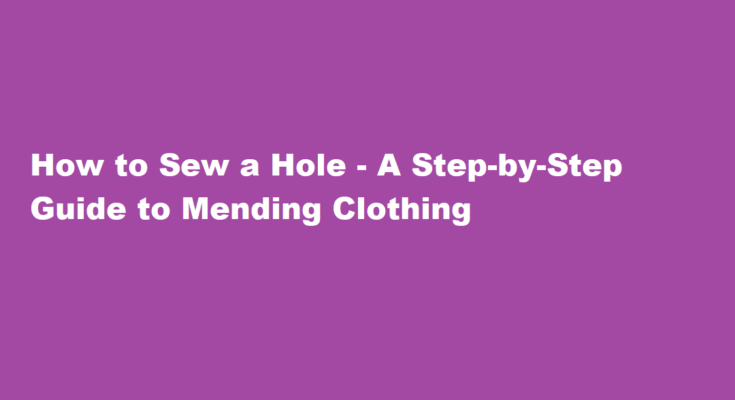Introduction
We’ve all been there: a favorite pair of jeans, a beloved sweater, or a cherished jacket suddenly sports an unsightly hole. Before you consign your once-beloved garment to the trash, consider learning how to sew a hole. Sewing a hole is a practical skill that can save you money and reduce waste. In this step-by-step guide, we will walk you through the process of mending your clothing and giving it a new lease on life.
Materials You’ll Need
Before you begin sewing a hole, gather the necessary materials
1. Needle: Choose a sewing needle that is appropriate for the fabric you’re mending. For most clothing, a general-purpose needle will suffice.
2. Thread: Select a thread color that matches your garment. For durability, use a thread made of natural fibers, like cotton or polyester.
3. Scissors: Sharp scissors are essential for cutting thread and fabric cleanly.
4. Fabric Patch (optional): If the hole is large or the fabric is too damaged, you may need a fabric patch that matches the original material.
5. Pins: Sewing pins can help keep the fabric in place while you work.
Prepare Your Work Area
Find a clean, well-lit, and flat surface to work on. Ensure your fabric is clean and free of wrinkles, as these can affect your stitching.
Thread the Needle
Thread your needle with a length of thread (around 18-24 inches). To make it easier, wet the thread’s end to prevent fraying and make it more manageable.
Knot the Thread
Tie a knot at the end of your thread. To do this, fold the end of the thread over the needle’s eye, creating a loop. Pull the thread through the loop, and tighten the knot.
Position the Fabric
Lay the garment flat, with the hole in the center. If there are frayed edges around the hole, trim them carefully to create clean, even edges.
Stitching Techniques
There are various stitching techniques you can use to repair a hole. Here are two common methods
a. Running Stitch: This simple stitch is ideal for smaller holes. Start from the inside of the garment and pass the needle through the fabric, pulling it until the knot catches. Bring the needle up a short distance away and then insert it back down, creating a straight line of stitches. Repeat until the hole is covered. For added strength, create a second row of running stitches next to the first.
b. Patching: For larger holes or areas with extensive damage, consider patching. Cut a fabric patch that matches your garment and place it behind the hole. Pin the patch in place and use a running stitch to sew around the hole’s edge and secure the patch. This technique not only mends the hole but reinforces the surrounding fabric.
Securing the Thread
When you reach the end of your stitching or want to secure your work, tie a knot on the inside of the fabric. To do this, insert the needle through the last stitch loop, creating a small loop. Pass the needle through this loop and pull it tight. Repeat this process once or twice to ensure a secure knot. Trim any excess thread with your scissors.
Final Touches
Inspect your work to make sure the hole is securely mended and the thread is tight. If you’ve used a patch, make sure it’s attached firmly. Iron the fabric to flatten and blend the stitches with the surrounding fabric.
Clean Up
Finally, put your sewing materials away and dispose of any fabric scraps or loose threads properly.
FREQUENTLY ASKED QUESTIONS
What is the best stitch for sewing a hole?
You can use any hand stitches to secure the patch behind the hole. Suitable stitches include running stitch, backstitch, and blanket stitch. You can decide to make the rip and patch a feature with contrasting thread or to try and make it as invisible as possible.
What are the 4 types of sewing?
Hand stitching, machine sewing, serging, and overlocking are the four primary forms of sewing. The most fundamental sort of sewing is hand sewing, which is accomplished with a needle and thread. It is frequently employed for little tasks like buttoning clothing or making repairs.
Conclusion
Learning how to sew a hole in your clothing is a valuable skill that can extend the life of your favorite garments and reduce your environmental footprint. It’s an empowering and cost-effective way to maintain your wardrobe, as well as an eco-friendly choice that minimizes textile waste. With some practice and patience, you can confidently repair small holes and tears in your clothing, helping you cherish your garments for longer and make a positive impact on the planet. So, the next time you find a hole in your favorite piece of clothing, don’t despair – pick up a needle and thread, and give it a second chance at life.
Read Also : How Old Do You Have to Be to Rent an Airbnb?



